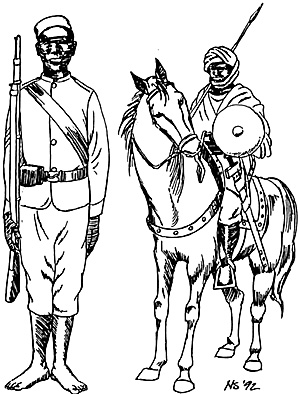 Light Cavalry
Light Cavalry
The majority of the cavalry were light cavalry. An emirate had a minimum of one thousand light cavalry and large wealthy ones like Kano or Nupe could field up to ten thousand. It appears that the cavalry were organized into units of fifty men under a captain.
From Left to right: Sargeant, Royal Niger Company (wears Sarg. sash, blue fez without tassel). Fulani Horseman.
The riders wore loose-fitting white gowns of coarse cotton. Their heads were protected by the several folds of their turbans. There were two styles of shields. The Fulani shield (kutufani) was round, two or three feet in diameter. The Hausa shield (garkuwa) was a five by two foot rectangle. These shields were made of the tanned hide of elephant, buffalo, antelope, or others. They were extremely durable, light, and supple, superior to metal or wood in proportion to their weight.
A variety of saddles were used, the most common one being high-peaked before and behind, and was used by both light and heavy cavalry. Other horse trappings included bridle and bit combinations, quilted saddle covers and stirrups. The latter were either small toe stirrups or large shovelshaped instruments with sharp edges, which could be used as offensive or defensive weapons.
The light cavalry armament consisted of a variety of javelins or spears (2 or 3 carried), swords, cudgels, maces or battleaxes, thrusting lances, and knives or daggers.
The light cavalry was a flexible and multifunctional force. It provided shock power in battle, and also was well adapted for raiding, reconnaissance, flank protection for the army on the march, and pursuit of defeated enemy troops.
Heavy Cavalry
The elite of the cavalry was the heavy cavalry, called Yan lifida after the quilted cotton arrow-proof armor (lifida) worn by both rider and mount. This armor was manufactured locally, and fitted to therider in pieces: the bantan lifidi covered the loins, thighs, and abdomen, the safa the upper torso, and the kumakumi was worn as a corslet.
Usually the emir's bodyguard (barde) were equipped with chain mail (Sulke) over the quilted armor. The chain mail was imported. Sometimes the warhorses were outfitted with breast plates. The helmet (kwalkwali) was a padded headpiece made of bound rags, sometimes covered by a tin brass receptacle or chain mail, and decorated with the feathers of an ostrich or other brightly colored bird. The shields were like those of the light cavalry, but the circular version was about five feet in diameter.
Since the heavy cavalry were either wealthy men or clients and slaves outfitted by the wealthy, their clothing and quilted armor were often of very colorful material. In modern photos of Nigerian nobles in ceremonial dress, their tunics are divided into several vertical panels of different colors. Also nobles seem to prefer turbans of black silk with gold embroidery.
The main offensive weapon of the lifida was the six foot metal lance. Its butt end was shaped like an axehead and rested in the stirrup. The head was about 8 inches long and barbed. the shaft was inlaid with brass and sometimes bore a brass knob about two-thirds of the way down to balance the weight of the head. A variety of swords, war-clubs, and battle-axes were also used by the heavy cavalry for close quarters fighting.
The armored bodyguard served as a mobile shield for the emir and his field headquarters in battle. The average size of the bodyguard cavalry was one hundred, and there were only a few hundred heavy cavalry in an army. The heavy cavalry was the strike force of the army. Although slower than the light cavalry, it was a formidable unit, capable of penetrating enemy battle lines and assaulting lightly fortified positions.
Many of the horsemen were accompanied by special detachments of foot soldiers who carried and cared for extra weapons and equipment for the mounted men.
Armies of the Sokoto Caliphate The Yucatan Indian Uprising 1847-1855
- Introduction and Army Organization
Cavalry
Infantry and Artillery
Officers and Fortifications
The Warfare State
The British Invasions 1897-1903
Wargaming
Back to Table of Contents -- Savage and Soldier Vol. XXIII No. 3
Back to Savage and Soldier List of Issues
Back to MagWeb Magazine List
© Copyright 1992 by Milton Soong.
This article appears in MagWeb.com (Magazine Web) on the Internet World Wide Web.
Other articles from military history and related magazines are available at http://www.magweb.com